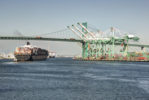
Global autonomous last-mile delivery is on its way to becoming a nearly $85 billion industry by 2030, an almost eight-fold increase from 2021. And retailers and delivery services alike are gearing up for the demand.
To do so, retailers, restaurants, and other e-commerce businesses are looking to adopt autonomous delivery services that not only provide end-to-end logistical and technological service, but also supply fast, safe, green and affordable last-mile fulfillment. Doing so gives businesses of all sizes the ability to tighten their in-store operations, while an autonomous system does the literal heavy lifting.
However, autonomous delivery services come in many shapes and kinds, none of which provides a one-size-fits-all solution. Different markets and infrastructures pose unique challenges when determining the most suitable autonomous service for any business.
Autonomous deliveries are typically carried out either by ground-based robots or airborne drones, but neither is always the right choice for any given context. Knowing the strengths and weaknesses of each option, especially where each mode of delivery shines, is invaluable for businesses looking to solve their last-mile delivery pain points.
The Urban Challenge
Densely populated urban areas often result in lower delivery costs for businesses, with more deliveries per mile. But cities pose acute challenges for traditional delivery methods, such as traffic snarls, lack of parking, and even safety issues for delivery personnel.
To counter these last-mile issues, small to semi-large self-driving sidewalk and road robots, equipped with route-optimization systems, have been deployed in multiple cities around the world. Already they’ve been shown to help alleviate common city frustrations like road and sidewalk congestion, parking limitations and prolonged delivery times, all while consuming far less energy than that of a standard passenger vehicle or even mopeds and bikes. Over the past few years, these automated systems have proliferated, with companies like Nuro and Kiwibot expanding the range of their services across urban markets such as fast food chains, grocery stores, university campuses and more.
The Suburban Strategy
Although road-based autonomous units lend themselves well to urban settings, they’re far less suited for suburban areas, where, in addition to resident populations being far less concentrated, last-mile delivery challenges are essentially reversed: traffic congestion is typically rare and parking is abundant. Though traditional couriers are only able to complete roughly two deliveries per hour due to the larger distances they need to cover between houses, they still run literal circles around the urban delivery robots, whose slower speeds and traffic-reducing benefits are much less relevant.
Though demand for instant gratification is no different in the suburbs, on-demand delivery is often deemed economically impractical in such areas. Thus, the U.S suburbs have remained on the periphery of the ultrafast delivery revolution — that is, until the emergence of automated airborne drone delivery.
Drones provide short-range, high-bandwidth, and low-margin last-mile fulfillment, translating into speedier and cheaper deliveries for suburban residents. The COVID-19 pandemic, with its stay-at-home mandates and social distancing, only heightened the already growing demand for ultrafast delivery services in the suburbs.
Businesses that incorporate automated drone delivery can slash the typical cost of ultrafast delivery by as much as 50%, and simultaneously cut costs for customers. With a single drone operator executing upwards of 10 deliveries per hour, businesses can satisfy customer demand for instant gratification, while paying less for transportation costs typically associated with traditional ultrafast delivery methods.
Despite their efficiency, drones are far less suited to urban areas. The infrastructure of urban communities — high-rise buildings, electric wiring and lack of open property space for landings or drops — simply doesn’t allow for this type of solution. If anything, it would draw more complaints than praise from city folk.
The Future Is Automated
Urban and suburban areas present varying degrees of last-mile delivery challenges. Businesses that understand the differences and know how to navigate them can streamline their autonomous delivery operations as well as boost their bottom lines.
There may not be a singular all-encompassing method for on-demand delivery across America’s metropolises and suburbs, but automation certainly yields the capabilities necessary for each market landscape, paving the way for higher efficiency standards and minimal environmental impact.
As autonomous delivery options expand throughout the world, governmental bodies are following suit to provide the regulatory framework needed to help them proliferate.
Residents across American suburbia can have their morning coffee or bagel delivered by drone, while city dwellers can have their lunch delivered by bot — faster, cheaper, and more efficiently, no matter where they live.
Yariv Bash is chief executive officer and co-founder of Flytrex.







